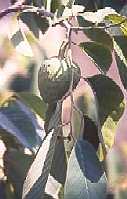View crop
View crop Data sheet EcoPortAnnona cherimola
 |
|
| Notes |
|---|
| BRIEF DESCRIPTION A small tree reaching 3-10 m in height. Leaves are 12-20 cm long, flowers are fragrant and pale yellow and the fruit is a pseudocarp formed by the fusion of the carpels and the receptacle into a fleshy mass, 10-15 cm in diameter and purple white. USES The fruit, which contain 18% sugar, is normally eaten fresh. The pulp can be utilized as a flavouring of ice-cream, sherberts and beverage. The green fruit and seed have vermicidal and insecticidal properties. KILLING T Young trees may not tolerate -2°C, while mature trees may withstand -3°C. GROWING PERIOD Perennial deciduous tree, growing about 270 days per year. The tree drops its leaves in the cool season and remain bare and dormant for several months. It begins to bear 3-4 years after planting or 4-5 years after sowing. COMMON NAMES Cherimoya, Cherimole, Cherimoyer, Chirimoya, Cirimoia, Corossol du Perou, Anone, Annona, Cherimaya baum, Peruanischer frachenbaum, Anon, Chirimoyo del Peru, Chirimorrinon, Anona do Chile, Chirimolia, Pearl of the Andes, Queen of subtropical fruits, Yuructira, Cherimalla, Cherimoyales. Anona del Peru, Cachiman de la China, Catuche, Momona, Girimoya, Masa, Cherimolia, Fruta do conde, Cabeca de nogro, Chirimoyabaum, Peruanisher flaschenbaum, Flachsbaum, Noina ostrelia. FURTHER INF Scientific synonyms: A. Cherimolia, A. Cherimoya, A. pubescens, A. tripetata. Cherimoya is probably native to the tropical highlands of Peru and Ecuador. In the tropics the tree is only grown at altitudes between 900-2000 m and will not survive under lowland conditions. It is grown in subtropical lowlands. The tree grows in areas with a dry season. Young trees need partial shade, low humidity prevents pollination, while high humidity can lead to fruit rot and high winds may break off fruit-laden branches. Yields are variable and range from 5-20 t/ha per year. | Sources |
| SOURCES (A. cherimolia Miller) Popenoe W 1974 pp 161-177 [USE, TEMP, RAIN, FER, TEXT, DEP] Williams C 1979a pp 123 [USE] Bourke D 1976 pp 223 Rice R 1990 pp 111 [USE] Purseglove J 1974 pp 625 [USE] Samson J 1986 pp 275-278 [KTMP, RAIN, PH, TEMP, LIG, TEXT] Roecklein J 1987 pp 205 [USE, TEMP] Vietmeyer N 1989 pp 229-239 [USE, LIMIT, PHO, RAIN, KTMP, PH] Sauls J 1984 FC 23 IBPGR 1986 pp 20 Lotschert W 1983 pp 223 Williams C 1982 Vandenput R 1981 pp 969 Samson J 1991 pp 276 Verheij E 1991 pp 71-75 [USE, KTMP, TEXT, FER, DRA, DEP] |